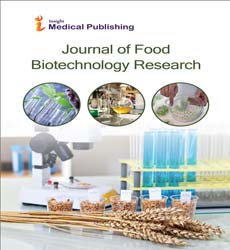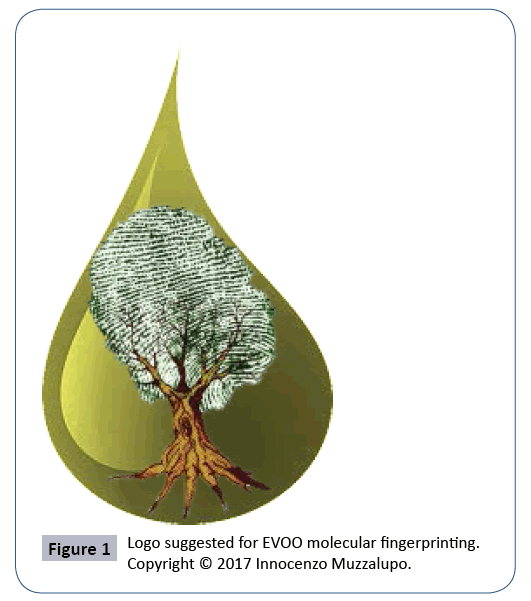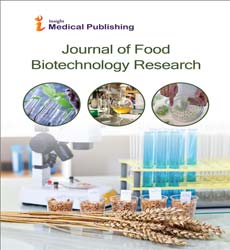Variety Traceability of Extra Virgin Olive OilS
Innocenzo Muzzalupon*
Council for Agricultural Research and Economics, Research Centre for Olive, Citrus and Tree Fruit (CREA-OFA) C.da Li Rocchi-Vermicelli, Rende (CS), Italy
- *Corresponding Author:
- Innocenzo Muzzalupon
Council for Agricultural Research and Economics
Research Centre for Olive
Citrus and Tree Fruit (CREA-OFA) C.da Li Rocchi- Vermicelli
87036 Rende (CS), Italy
Tel: +39(0) 0984 493173
E-mail: innocenzo.muzzalupo@crea.gov.it
Received Date: November 07, 2017; Accepted Date: November 07, 2017; Published Date: November 14, 2017
Citation: Muzzalupon I (2017) Variety Traceability of Extra Virgin Olive Oils. J Food Biotechnol Res. Vol.1 No.1:4
Editorial
Food genomics relies on the hypothesis that remnant DNA in a food matrix can be recovered to serve as an analyte in food authenticity analyses [1]. As recent reviewed this hypothesis has led to the successful development of DNA-based food authenticity tests [2-4].
Recently, an initiative of the European Parliament has identified a number of foods such as Extra Virgin Olive Oil (EVOO), fish, honey, dairy products and meat as being the target of fraudulent activities. This initiative calls for the development of technologies and methods to detect food fraud [4].
At international level, olive oil quality is regulated by the International Olive Council (IOC) trade standard, CODEX Alimentarius at EU level by Regulation (EEC) n° 2568/91, establishing a list of chemical and organoleptic characteristics, as well as methods for their analysis. This list and the methods are regularly updated to reflect scientific progresses. Despite this regulation, detection methods are lacking for certain fraudulent manipulations [5] (Figure 1).
Some olive varieties are identified as being of higher quality because they derive from particular ancient olive cultivars and from well-defined geographical areas and generally are legally protected. Indeed, the aims of the Protected Designation of Origin (PDO), the Registered Designation of Origin (RDO) or the Protected Geographical Indication (PGI) status, are to add value to certain high-quality products obtained from particulars olive varieties cultivated in a specific geographic area. Therefore, the identification of olive genotypes used for EVOO production is essential for the final characteristics of designation oils (PDO, RDO, IGP, etc.).
The EEC n° 2081/1992, has defined the relative contribution of specific cultivars for every commercial oil designation. For this reason, it is necessary to develop procedures for cultivar identification, in order to be able to directly demonstrate that the legally mandated cultivar composition has been respected [4].
Although, different types of analysis can be useful to authenticate the EVOOs, conventionally assessed, analyzing the content of metabolites such as: fatty acids, triacyl glycerols, n-alkanes, volatile compounds and tocopherols [6-8], the characterization of the genetic identity of DNA recoverable from EVOO is the only technique that guarantees the identification of different contributions of olive varieties to the EVOOs mixture, as stated by each Designation Regulation [2]. In addition, the DNA-based technologies are not influenced by environmental conditions and provide an opportunity for direct comparison of different genetic materials reported in the databases. The employment of DNA-based markers in EVOO characterization offers a number of advantages over biochemically-based markers such as an increased specificity, sensitivity and a reliable performance with highly processed samples [1,9].
PCR-based techniques are often essential in order to amplify the residual DNA in a food matrix to useful quantities for downstream analyses, but all genotyping platforms can be utilized in food genomic analyses. Amplified fragment length polymorphism (AFLP), random amplified polymorphic DNA (RAPD), inter-simple sequence repeats (ISSR), simple sequence repeats (SSR) or microsatellites, and single nucleotide polymorphisms (SNP) have been proposed to identify olive cultivars and for traceability of EVOO. At present, SSRs are the most relevant genetic markers used in olive cultivar characterization and EVOO authenticity, thanks to their numerous properties. Indeed, SSR markers are multiallelic, codominant, highly polymorphic, widely distributed along the plant genomes and easily amenable to PCR-based analyses. Moreover, they have great reproducibility and currently, they are the most reliable DNA profiling techniques in forensic investigation [10]. However, SSRs are one of the most useful molecular markers in plant breeding, and they are widely used for olive cultivar fingerprinting [10-16].
The evidence of authenticity of an oil sample claimed to be obtained from a specific cultivar generally should reside in the match between its microsatellite profile and the one of plants (leaves), reported in reference databases. In this context, to efficiently identify and analyze the unknown commercial VOOs, the development of a database, including information about olive cultivars and olive oils based on genetic data sets, particularly, SSR markers, becomes necessary [4,17].
However, the reliability and reproducibility of the profiles obtained by means of molecular markers appear strictly dependent on the quality of the DNA extracted from oil [4,18]. Therefore, extraction and recovery of DNA from olive oil is a key and hard step in the process, as addressed by different authors [4,18-21]. Among these oil-based studies, there have been efforts to evaluate the degree of similarity between oil DNA and leaf DNA [4,22-24].
In some publications, authors report discrepancies between the results obtained from versus oils, suggesting differences in the quality of the DNA that is extracted [4] and even going so far as to suggest that the commercial monovarietal olive oils might contain 5-10% of oil derived from other cultivars [23]. Finally, several reports claimed a relatively high stability of olive oil DNA during storage [25].
DNA extracted from VOO can be highly degraded and contaminated with inhibitors of the PCR reaction, which limit the applicability of DNA genetic markers to the traceability of VOO [23,26,27]. This drawback could be overcome by improving the DNA isolation method and by optimizing the amplification system.
In recent years, many papers dealing with the development of new protocols [9,18,22,28] or the comparison of different methods to find an adequate approach [4,21] Scollo et al. [21] applied droplet digital PCR (ddPCR) to quantify the DNA recovered from oil by applying different methods. The authors demonstrated that the methods could modify the quantity/ quality of recovered DNA and overall reproducibility. The ddPCR is an endpoint PCR [21,29], enabling the quantification of DNA irrespective of the efficiency of the PCR. The efficiency of the PCR can be influenced by the presence of inhibitors whose presence can result in the lack of reproducibility.
Very recently, the purification of extracted DNA by excision of the less degraded fragments from agarose gel and subsequent electroelution has been proposed [18], whereas another approach proposed to totally by-pass the DNA extraction step by exploiting a DNA polymerase. In the last case, the DNA polymerase (KAPA3G Plant DNA polymerase, Kapa Biosystems, Inc., Boston, MA, USA) was able to tolerate PCR inhibitors applied directly on crude oil [19]. These latest molecular results may be used to mark the origin for the olive oils produced by these varieties. In addition, by contributing to a better understanding of cultivated olive germplasm relationships, molecular results can provide useful information for cultural purposes, aimed to preserve the cultural and historical heritage, represented by ancient olive trees [30].
The need of further working towards the quantification of varietal composition, by taking advantage of the great potential of HRM and qRT-PCR techniques and the most recent omics technologies, remains in the near future [31].
The comparing between the molecular SSR profiles, obtained from the EVOO by using a DNA polymerase able to tolerate PCR inhibitors, and the same loci present in an online molecular databases, allows establishing the origin olive varieties and the respect for the disciplinary of production (POD, RDO, PGI, etc). In Italy, some laboratories already work on this certification and by computerizing the molecular profiles obtained from the EVOO, can process an "identity card" containing the commercial information and the molecular footprint of the oil. This "identity card" can be inserted into a barcode or QR code or microchips on the labels or bottle caps and it can be consulted by a smartphone.
References
- Agrimonti C, Vietina M, Pafundo S, Marmiroli N (2011) The use of food genomics to ensure the traceability of olive oil. Trends Food Sci Technol 22: 237–244.
- Kalaitzis P, El-Zein Z (2016) Olive oil authentication, traceability and adulteration detection using DNA-based approaches. Lipid Technol 28: 173-176.
- Madesis P, Ganopoulos I, Sakaridis I, Argiriou A, Tsaftaris A (2014) Advances of DNA-based methods for tracing the botanical origin of food products. Food Res Int 60 163-172.
- Pasqualone A, Montemurro C, di Rienzo V, Summo C, Paradiso V, et al. (2016) Evolution and perspectives of cultivar identification and traceability from tree to oil and table olives by means of DNA markers. J Sci Food Agric 96: 3642-3657.
- Ferreiro-González M, Barbero GF, Álvarez JA, Ruiz A, Palma M, et al. (2017) Authentication of virgin olive oil by a novel curve resolution approach combined with visible spectroscopy. Food Chem 220: 331-336.
- Messai H, Farman M, Sarraj-Laabidi A, Hammami-Semmar A, Semmar N (2016) Chemometrics methods for specificity, authenticity and traceability analysis of olive oils: principles, classifications and applications. Foods 5: 77-112.
- Mihailova A, Abbado D, Kelly SD, Pedentchouk N (2015) The impact of environmental factors on molecular and stable isotope compositions of n-alkanes in Mediterranean extra virgin olive oils. Food Chem 173: 114-121.
- Semmar N, Laroussi-Mezghani S, Grati-Kamoun N, Hammami M, Artaud J (2016) A new simplex chemometric approach to identify olive oil blends with potentially high traceability. Food Chem 208: 150-160.
- Ramos-Gòmez S, Busto MD, Albillos SM, Ortega N (2016) Novel qPCR systems for olive (Oleaeuropaea L.) authentication in oils and food. Food Chem 194: 447-454.
- Abdessemed S, Muzzalupo I, Benbouza H (2015) Assessment of genetic diversity among Algerian olive (Oleaeuropaea L.) cultivars using SSR markers. Scientia Horticulturae192: 10-20.
- Ben-Ayed R, Ben Hassen H, Ennouri K, Ben Marzoug R, Rebai A (2016) OGDD (Olive Genetic Diversity Database): a microsatellite markers’ genotypes database of worldwide olive trees for cultivar identification and virgin olive oil traceability. Database (Oxford).
- Mousavi S, Mariotti R, Regni L, Nasini L, Bufacchi M, et al. (2017) The first molecular identification of an olive collection applying standard Simple Sequence Repeats and novel expressed sequence Tag markers Front Plant Sci19: 1283.
- Ben Ayed R, Kamoun-Grati N, Rebai A (2013) An overview of the authentication of olive tree and oil. Compr Rev Food Sci Food Saf 12: 218-227.
- Muzzalupo I, Vendramin GG, Chiappetta A (2014) Genetic biodiversity of Italian olives (Oleaeuropaea) germplasmanalyzed by SSR markers. Sci World J 2014: 296590.
- Sakar E, Unver H, Ercisli S (2016) Genetic diversity among historical olive (Oleaeuropaea L.) genotypes from Southern Anatolia based on SSR markers. Biochem Genet 54: 842-853.
- Sorrentino G,Muzzalupo I, Muccilli S, Timpanaro N, Russo MP, et al. (2016) New accessions of Italian table olives (Oleaeuropaea): Characterization of genotypes and quality of brined products. Scientia Horticulturae213: 34-41.
- Sebastiani L, Busconi M (2017) Recent developments in olive (Oleaeuropaea L.) genetics and genomics: applications in taxonomy, varietal identification, traceability and breeding. Plant Cell Rep 36: 1345-1360.
- Raieta K, Muccillo L, Colantuoni V (2015) A novel reliable method of DNA extraction from olive oil suitable for molecular traceability. Food Chem 172: 596-602.
- Muzzalupo I, Pisani F, Greco F, Chiappetta A (2015) Direct amplification of the virgin olive oil for the traceability and authenticity. Eur Food Res Technol 241: 151-155.
- Ramos-Gòmez S, Busto MD, Perez-Mateos M, Ortega N (2014) Development of a method to recovery and amplification DNA by real-time PCR from commercial vegetable oils. Food Chem 158: 374-383.
- Scollo F, Egea LA, Gentile A,La Malfa S, Dorado G,et al. (2016) Absolute quantification of olive oil DNA by droplet digital-PCR (ddPCR): Comparison of isolation and amplification methodologies. Food Chem 213: 388-394.
- Alonso-Rebollo A, Ramos-Gómez S, Busto MD, Ortega N (2017) Development and optimization of an efficient qPCR system for olive authentication in edible oils. Food Chem 232: 827-835.
- Doveri S, O’Sullivan DM, Lee D (2006) Non-concordance between genetic profiles of olive oil and fruit: a cautionary note to the use of DNA markers for provenance testing. J Agric Food Chem 54: 9221-9226.
- Muzzalupo I, Pellegrino M, Perri E (2007) Detection of DNA in virgin olive oils extracted from destoned fruits. Eur Food Res Technol 224: 469-475.
- Spaniolas S, Bazakos C, Ntourou T, Bihmidine S, Georgousakis A, et al. (2008) Use of lambda DNA as a marker to assess DNA stability in olive oil during storage. Eur Food Res Technol 227: 175-179.
- Montemurro C, Miazzi MM, Pasqualone A, Fanelli V, Sabetta W, et al. (2015) Traceability of PDO olive oil ‘Terra di Bari’ using high resolution melting. J Chem 2015: 496986.
- Pasqualone A, Alba V,Mangini G, Blanco A, Montemurro C (2010). Durum wheat cultivar traceability in PDO Altamura bread by analysis of DNA microsatellites. Eur Food Res Technol 230: 723-729.
- Uncu AT, Uncu AO, Frary A, Doganlar S (2017) Barcode DNA length polymorphisms vs fatty acid profiling for adulteration detection in olive oil. Food Chem 221: 1026-1033.
- Pinheiro LB, Coleman VA, Hindson CM, Herrmann J, Hindson BJ, et al. (2012) Evaluation of a droplet digital polymerase chain reaction format for DNA copy number quantification. Anal Chem 84: 1003-1011.
- Chiappetta A, Muto A, Muzzalupo R, Muzzalupo I (2017) New rapid procedure for genetic characterization of Italian wild olive (Oleaeuropaea) and traceability of virgin olive oils by means of SSR markers. Scientia Horticulturae 226: 42-49.
- Chiappetta A, Bruno L, Muzzalupo I (2015) Chapter 2-Omics approaches for the characterization and valorisation of olive varieties. In: Muzzalupo I, Micali S (eds.), Agricultural and food biotechnologies of Oleaeuropaea and stone fruit.Bentham Science Publishers LTD, Sharjah, U.A.E. pp: 75-108.

Open Access Journals
- Aquaculture & Veterinary Science
- Chemistry & Chemical Sciences
- Clinical Sciences
- Engineering
- General Science
- Genetics & Molecular Biology
- Health Care & Nursing
- Immunology & Microbiology
- Materials Science
- Mathematics & Physics
- Medical Sciences
- Neurology & Psychiatry
- Oncology & Cancer Science
- Pharmaceutical Sciences

